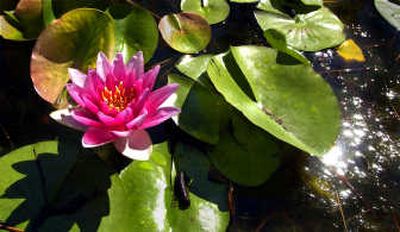Water feature enlivens landscape

Water is almost a magical element when put into a garden. It catches and bounces light in different directions, adding an unpredictable element. When it is in motion, it adds excitement and serves to direct the garden walker’s view to other points of interest along its route. The sound of water falling over a waterfall or rocks is instinctively relaxing to humans. And it’s important to remember that a garden pond will draw all kinds of wildlife to your garden.
For Jim Walsh of Coeur d’Alene, this means both a simple tickling fountain in a large pot and a small pond that he says the raccoons have way too much fun in. According to Walsh, talking to people who have built water features and ponds is one of the best ways to learn what you really want. They can tell you what worked and probably more importantly, what didn’t work for them. To help with this, Walsh and members of the Inland Empire Water Garden and Koi Society are opening their ponds and gardens this Sunday so you can learn from their experiences. They will even have a few ideas about selecting plants and fish and keeping raccoons and herons from treating them like a private salad and sushi bar.
Want to build your own pond? Here are a few tips from the experts:
Location is important
Pick the sunniest spot available but not at the lowest point on your property. Most water plants, especially the blooming water lilies, need six to eight hours of sun to do well. Low spots collect normal runoff patterns that may bring in debris and other garden fertilizers and chemicals that can kill pond life. Try to avoid putting the pond under trees. Leaves, needles and other materials can clog filters, gunk up the pond quickly and shift the chemical balance of the water enough to harm the fish. Last, put your pond where you can see it from the house and with enough room around it to allow people to sit comfortably. This will allow you to enjoy the pond from indoors or out.
The right stuff
Ponds can be built out of several different materials, depending how big you want them. Containers for patios and decks can be any large pot or tub that can hold water. Larger ponds can be made of rigid preformed fiberglass or plastic or a flexible liner made of a rubber material that can be purchased in widths from a few feet to more than an acre and in any length. Each material has its pros and cons, and pond owners on the tour can share their experiences.
Think big
Jim Walsh offers one important piece of advice: Regardless of the size of pond you choose to build, build it bigger than you think you want because if you get hooked on the hobby, you will be adding to it in just a couple of years.